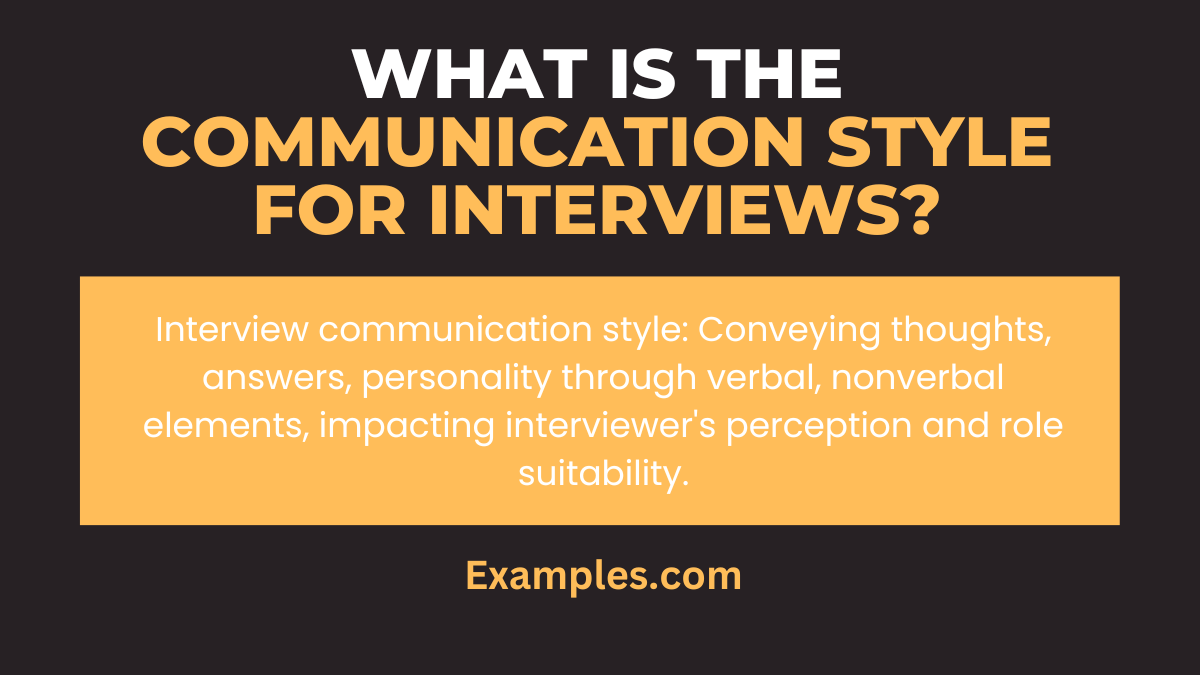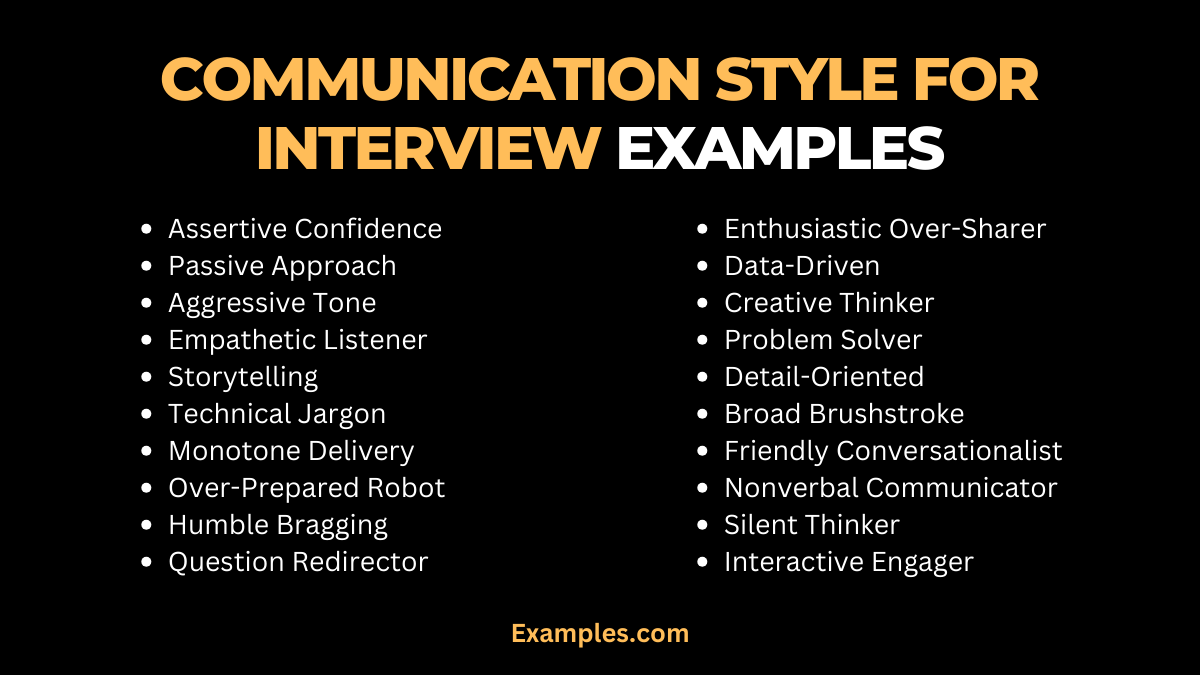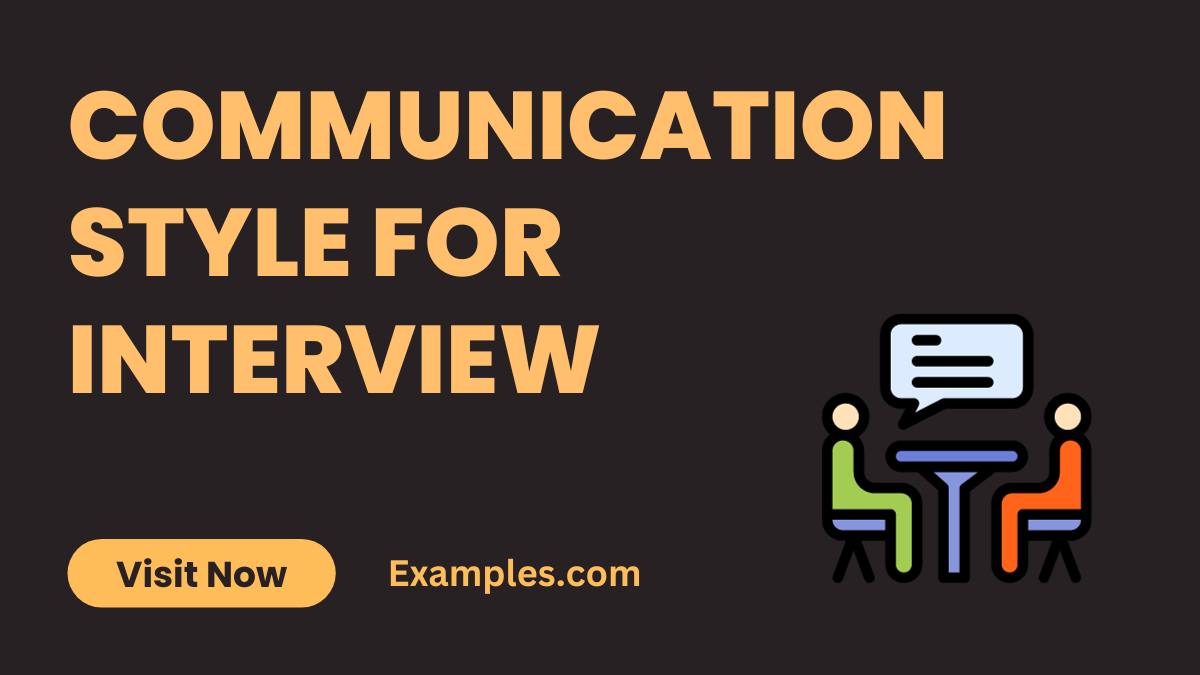19+ Communication Style for Interview Examples
Delve into the intricacies of interview success with our comprehensive guide on communication style for interview. This guide offers practical insights and Communication Examples to help you understand and master the nuances of effective interview communication. From body language to verbal cues, learn how to present your best self in any interview scenario. Enhance your skills and confidence with our expert advice and illustrative examples.
What is the Communication Style for Interviews? – Meaning

The communication style for interviews refers to the way a candidate conveys their thoughts, answers, and personality during an interview. It includes verbal and nonverbal elements like tone of voice, choice of words, body language, and active listening. This style plays a critical role in how the interviewer perceives the candidate’s suitability for the role, making it an essential aspect of interview preparation.
What is the Best Example of Communication Style for an Interview?

The best example of communication style for an interview is one that combines clarity, confidence, and empathy. This involves speaking clearly and confidently, while also being attentive and responsive to the interviewer’s questions and comments. It’s a style that balances assertiveness with respectfulness, showcasing one’s skills and experiences effectively without overpowering the conversation. Such a communication style not only answers questions but also builds a rapport with the interviewer, leaving a lasting positive impression.
20 Communication Style for Interview Examples

Enhance your interview impact with these 20 varied communication style for interview examples. Each showcases a unique approach, its underlying causes, and tips for improvement.
- Assertive Confidence: Clear, direct.
Fix: Balance with listening. - Passive Approach: Understates skills.
Fix: Practice confidence. - Aggressive Tone: Overpowers.
Fix: Stay calm and respectful. - Empathetic Listener: Overly agreeable.
Fix: Add assertive opinions. - Storytelling: Engaging but lengthy.
Fix: Keep stories brief. - Technical Jargon: Overly complex.
Fix: Simplify language. - Monotone Delivery: Seems disinterested.
Fix: Vary tone. - Over-Prepared Robot: Lacks spontaneity.
Fix: Be natural. - Humble Bragging: Subtly boasts.
Fix: Be modestly direct. - Question Redirector: Avoids topics.
Fix: Answer directly. - Enthusiastic Over-Sharer: Too personal.
Fix: Stay professional. - Data-Driven: Fact-heavy.
Fix: Add personal insight. - Creative Thinker: Uniquely abstract.
Fix: Stay practical. - Problem Solver: Skips problem context.
Fix: Define before solving. - Detail-Oriented: Loses overview.
Fix: Summarize first. - Broad Brushstroke: Too general.
Fix: Use specifics. - Friendly Conversationalist: Informal.
Fix: Mix friendliness with formality. - Nonverbal Communicator: Weak verbal skills.
Fix: Practice speaking. - Silent Thinker: Hesitant pauses.
Fix: Be concise. - Interactive Engager: Overly dominant.
Fix: Balance interaction.
Effective Communication Style for Interview Tips
Incorporating various Communication Styles Examples into your interview strategy can significantly boost your chances. Effective communication in interviews is about adapting styles to the context, whether it’s assertive, open, or reflective.
- Engage with Clarity: Embody an Open Communication Style by being transparent and clear. “I value honesty and clarity in my professional interactions.”
- Positive Body Language: Reflect a Casual Communication Style through relaxed yet professional body language. “I approach challenges with a calm and open mindset.”
- Tailored Responses: Use a Reflective Communication Style to thoughtfully respond to questions. “Reflecting on my past experiences, I’ve learned valuable lessons.”
- Balanced Conversation: Communication styles in relationships play a role in creating a rapport with the interviewer. “Good communication is key to successful team dynamics.”
- Follow-Up Questions: Demonstrating an assertive communication style shows confidence and interest. “I am keen to know more about the company’s future plans.”
[ns_button size=”md” type=”download” value=”Download Communication Style for Interview with Successful Tips” href=”
Assertive Communication Style for Interview
An Assertive Communication Style is often considered the most desirable style of communication in interviews. It showcases confidence and respect for the interviewer’s perspective.
- Clear Standpoints: Exemplify assertiveness without aggression. “I confidently endorse my ideas while respecting others’ viewpoints.”
- Confident Responses: Avoid a Passive Communication Style by responding decisively. “I am fully prepared to take on these responsibilities.”
- Constructive Disagreement: Stay away from a Passive-Aggressive Communication Style. “I respectfully offer a different perspective on this issue.”
- Direct Questions: Reflect an Open Communication Style through straightforward inquiries. “What are the main challenges the team currently faces?”
- Decisive Language: Deter from a Manipulative Communication Style by being honest and direct. “I firmly believe in transparent and ethical professional practices.”
Communication Style for Project Manager Interview
For a project manager, Communication Styles in Leadership are vital. It’s about balancing assertiveness with empathy to manage teams effectively.
- Leadership Emphasis: Utilize a communication style that reflects leadership. “Leadership to me means guiding with both confidence and compassion.”
- Problem-Solving Approach: Stay clear of an aggressive communication style. “I address challenges calmly and with well-thought-out strategies.”
- Team Dynamics Understanding: Communication styles in the workplace are crucial for managing diverse teams. “I adjust my communication to suit different team dynamics.”
- Project Milestones Focus: Employ a types of communication styles approach to discuss milestones. “Different stages of the project require varying communication strategies.”
- Risk Management Skills: Reflective Communication Style aids in foreseeing and managing risks. “Reflecting on potential risks helps me prepare effective countermeasures.”
Communication Style for Fresher Interview
Freshers should focus on communication styles in relationships and how they apply to the workplace, demonstrating their potential for growth and adaptability.
- Enthusiasm for Learning: Show eagerness in a casual communication style. “I am excited to learn and grow in a professional environment.”
- Adaptability Showcase: Employ an open communication style to illustrate flexibility. “I adapt seamlessly to new environments and challenges.”
- Teamwork Experiences: Assertive communication style is key in teamwork. “I actively contribute to team projects with confidence and cooperation.”
- Relevant Academic Achievements: A reflective communication style helps relate academic success to job relevance. “Reflecting on my academic achievements, I see a direct relevance to this role.”
- Future Goals Alignment: Use a Types of Communication Styles approach to align personal goals with company vision. “I am eager to align my career aspirations with the company’s objectives.”
How to Answer Job Interview Questions About Communication Style?
When facing job interview questions about your communication style, it’s crucial to present your abilities in a way that aligns with the role’s requirements. Here’s a guide to help you articulate your communication style effectively.
- Identify Your Style: Reflect on your communication habits. Are you more of a direct communicator like many leaders, or do you have a collaborative approach similar to managers? Recognizing your style is the first step.
- Relate to the Role: If you’re applying for a leadership position, emphasize elements of the communication style for leaders. For a managerial role, focus on how your communication fosters team cohesion.
- Provide Examples: Concrete examples make your description more credible. If you’ve worked in a team, discuss how your communication style for work facilitated project success.
- Discuss Adaptability: Show that your communication style can evolve. For instance, if you’re applying for a project manager role, illustrate how your communication style for project managers adapts to different project phases and team dynamics.
- Highlight Continuous Improvement: Express your willingness to develop your communication skills further, drawing parallels to how students continually refine their communication.
Communication Style for Job Interview
Mastering your communication style for a job interview is crucial for making a strong impression. It’s not just about what you say, but how you say it. From understanding the nuances of body language to articulating your thoughts clearly, every aspect contributes to your overall effectiveness. Renowned interviewers and professionals have shared their insights on this topic. For instance, according to Buffer.com, even experienced interviewers like Terry Gross had to learn the Art Of Communication, emphasizing the importance of practice and adaptability in Developing a Good Conversation??.
How Do You Describe Communication Style in an Interview?
Describe your communication style by focusing on clarity, adaptability, and effectiveness. Highlight experiences and communication style assessment results that demonstrate your proficiency.
What Are the Types of Communication Styles?
The four types of communication styles are assertive, passive, aggressive, and passive-aggressive. Each style varies in approach and effectiveness in various settings like communication style for coaching.
In conclusion, mastering your communication style for interviews is pivotal. It’s about blending clarity, confidence, and empathy to make a lasting impression. With the examples and tips provided, you can navigate various scenarios, understanding the impact of different styles. Remember, effective communication is key to interview success, showcasing your skills and aligning with the organization’s values and culture.



